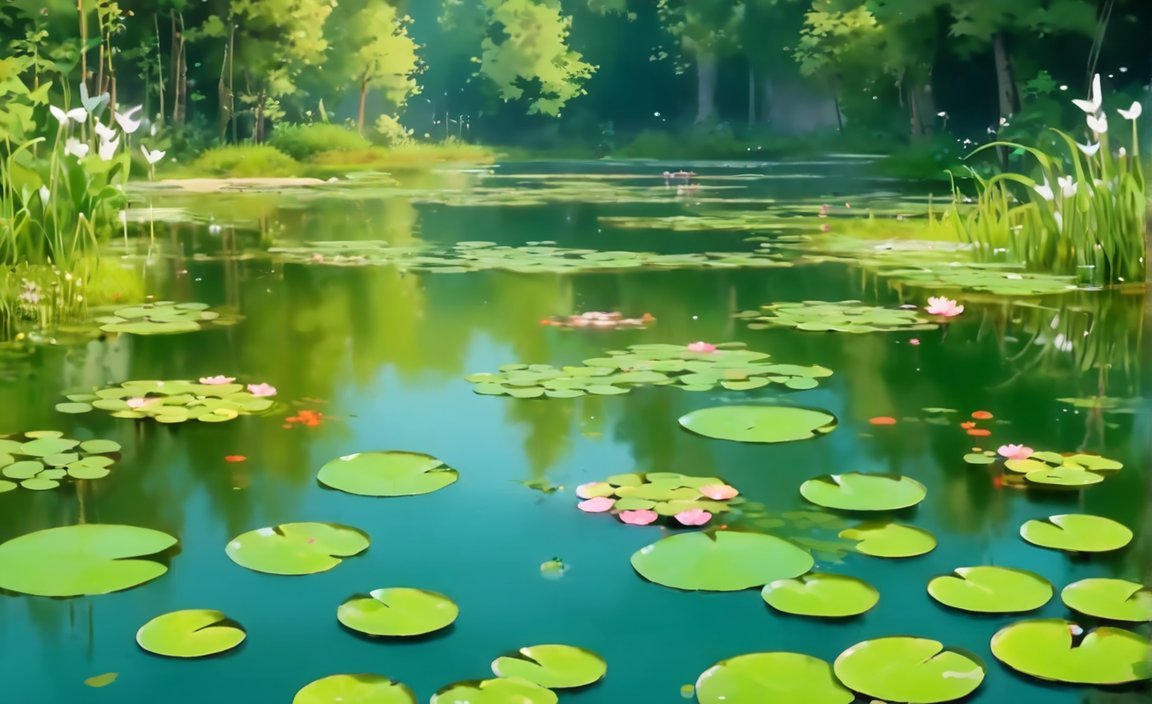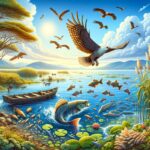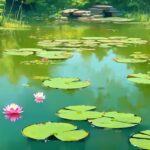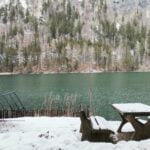Discover 10 Fascinating Pond Facts: Exploring Enchanting Aquatic Realms. Ponds, those seemingly small and unassuming bodies of water, hold a world of wonders waiting to be explored. As we dive into their depths, we uncover remarkable secrets and intriguing facts about these enchanting aquatic realms. From the diverse array of life they harbor to their vital role in ecosystem balance, join us on a captivating journey as we unveil 10 interesting facts that will leave you in awe of the beauty and significance of ponds.
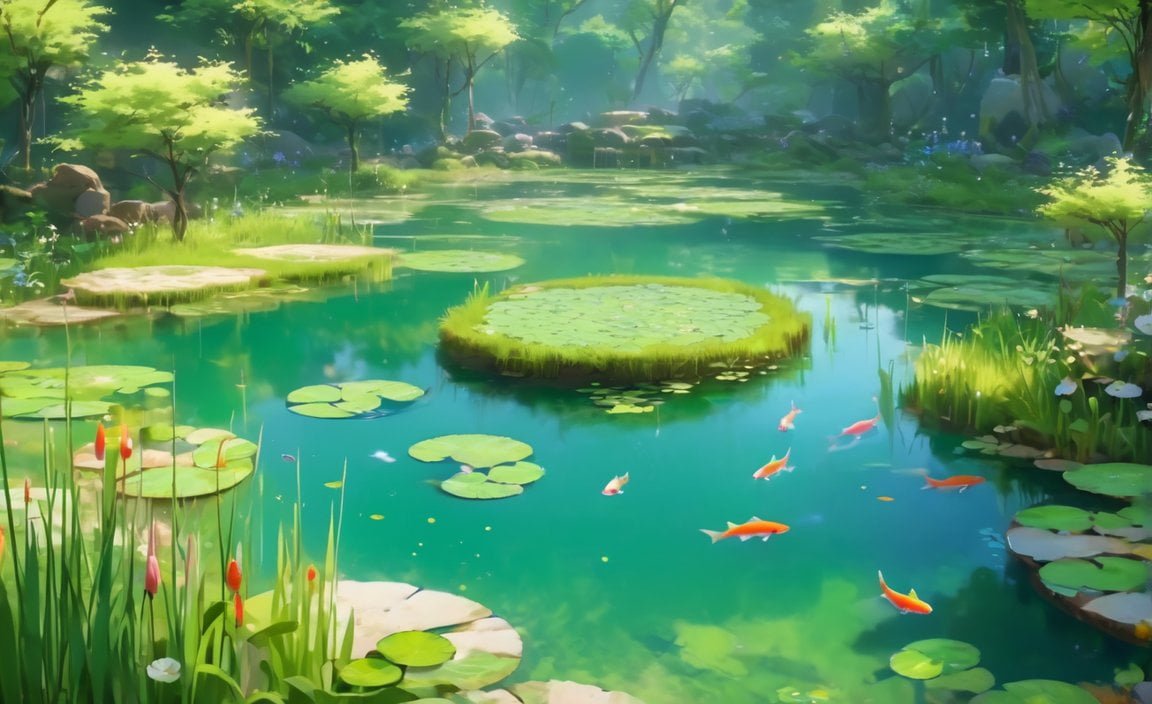
Key Takeaways:
- The largest pond can be as big as a lake.
- There are over 100 million ponds worldwide.
- Certain pond habitats have brackish water conditions.
- Every drop of pond water contains a diverse ecosystem.
- Ponds are crucial for the reproduction and growth of many animal species.
- Ponds serve as carbon repositories.
- Ponds can be either permanent or temporary in nature.
- Ponds and lakes share similarities but also have distinct characteristics.
- Healthy ponds support a wide variety of wildlife.
- Ponds provide safe havens for wildlife.
- Ponds hold historical significance.
10 Interesting Facts About Ponds
Ponds, with their serene and captivating presence, harbor a world of wonders beneath their calm surfaces. These small bodies of water offer a glimpse into the intricacies of aquatic ecosystems and their vital role in supporting life. Let’s dive into the enchanting world of ponds and explore ten fascinating facts!
1. A Pond Can Be as Large as a Lake
When we think of a pond, we often imagine a small body of water nestled amidst greenery. However, some ponds can be as vast as lakes, spanning over hundreds of acres. These sizable ponds can be home to a diverse array of plants and creatures, resembling miniature ecosystems of their own.
2. Ponds Abound Across the Globe
Ponds are not limited to any specific region. In fact, there are over 100 million ponds scattered around the world, each with its distinct characteristics. From the tranquil koi ponds in Japan to the vibrant wetlands of the Everglades, ponds can be found in every corner of the Earth, providing habitats for countless organisms.
3. Some Ponds Have Brackish Water
While freshwater is the most common type of pond, there are also ponds with brackish water conditions. Brackish ponds contain a mixture of freshwater and saltwater, creating a unique habitat for species adapted to these fluctuating salinity levels. These specialized ecosystems contribute to the incredible diversity of life within our planet’s ponds.
4. A Microcosm of Life in Every Drop
Don’t be fooled by their seemingly simple appearance; every drop of pond water contains a vibrant microcosm of life. From microscopic algae that form the foundation of the food chain to tiny aquatic insects skimming the water’s surface, ponds harbor a remarkable array of organisms at the microscopic level.
5. Vital Breeding Grounds for Many Animals
Ponds serve as invaluable breeding grounds for numerous animal species, especially amphibians. Frogs, toads, and salamanders rely on ponds to lay their eggs, which later hatch into tadpoles and undergo metamorphosis to become adults. Without the sheltered havens that ponds provide, the life cycles of these creatures would be disrupted.
6. A Storehouse for Carbon
Ponds play a significant role in carbon storage. Organic matter, such as decaying plant material and animal waste, accumulates at the bottom of ponds over time, forming a carbon sink. This process helps mitigate climate change by trapping carbon in the sediments, making ponds invaluable allies in our battle against global warming.
7. The Ever-Changing Nature of Pond Habitats
Ponds can exhibit a wide range of permanence, from temporary pools formed during rainy seasons to permanent bodies of water that persist year-round. These fluctuations in water availability shape the flora and fauna of pond habitats, creating dynamic ecosystems that constantly adapt to their changing conditions.
8. Similar, Yet Different from Lakes
Although ponds and lakes share many characteristics, they also have distinct features that set them apart. Ponds are generally smaller and shallower than lakes, allowing sunlight to reach the entire water column. This abundance of light fosters the growth of aquatic plants, creating lush habitats for a diverse array of organisms.
9. A Showcase of Varied Wildlife
Healthy ponds boast a rich biodiversity, harboring a multitude of plant and animal species. From graceful water lilies to darting dragonflies, ponds provide shelter, food, and breeding grounds for a captivating host of wildlife. Each visit to a pond offers a chance to encounter something new and awe-inspiring.
10. Ponds and their Historical Significance
Throughout history, ponds have played a role in human civilization, serving as sources of water for irrigation, transportation, and domestic use. They have served as locations for artistic inspiration, reflection, and leisure. Ponds, with their timeless charm, have woven themselves into the fabric of our cultural heritage.
In conclusion, ponds are not just peaceful bodies of water; they are teeming with life and stories waiting to be discovered. From their ecological significance to their historical importance, these enchanting aquatic realms are a testament to the wonders of our planet’s diverse ecosystems. The next time you encounter a pond, take a closer look, and marvel at the multitude of secrets it holds within its depths.
Here are 10 interesting facts about biomes that will blow your mind: 10 interesting facts about biomes.
Discover fascinating details about the process of condensation with these 10 interesting facts: 10 interesting facts about condensation.
Get ready to dive into the captivating world of marine biology with these 10 amazing facts: 10 interesting facts about marine biology.
Explore the wonders of marine life through these 10 incredible facts that will leave you in awe: 10 interesting facts about marine life.
Embark on a journey of knowledge and uncover 10 intriguing facts about the iconic Parliament House: 10 interesting facts about Parliament House.
Unearth fascinating insights about Parliament House in Canberra with these 10 captivating facts: 10 interesting facts about Parliament House Canberra.
Venture into the enchanting savanna biome and discover 10 captivating facts that will blow you away: 10 interesting facts about savanna biome.
Dive into the depths of the ocean and uncover 10 mind-blowing facts about sea creatures: 10 interesting facts about sea creatures.
Plunge into the mysterious world beneath the waves and learn 10 fascinating facts about sea life: 10 interesting facts about sea life.
Delve into the wonders of the taiga biome with these 10 astonishing facts that will leave you speechless: 10 interesting facts about taiga biome.
Ponds Play a Crucial Role in the Water Cycle
Ponds are not just stagnant bodies of water; they are dynamic ecosystems that play a crucial role in the water cycle. Let’s explore ten fascinating facts about ponds and discover the enchanting aquatic realms they create!
Fact 1: The Largest Pond is Langley Pond
Did you know that the world’s largest pond is Langley Pond, located in Burnettown, South Carolina? Spanning 285 acres, this pond is often considered to be just a few inches shy of being classified as a lake.
Fact 2: The Most Famous Pond is Walden Pond
Walden Pond, made famous through Henry David Thoreau’s book “Walden,” is America’s most renowned pond. It covers an area of 64.5 acres and was formed by retreating glaciers approximately 10,000 to 12,000 years ago.
Fact 3: Microbial Discovery in Pond Water
In 1674, scientist C. Anton van Leeuwenhoek used a microscope to discover microbes in pond water, which he named “animalcules.” This groundbreaking discovery opened our eyes to the vast microscopic life that thrives in ponds.
Fact 4: Pond Snails’ Algae Control
Pond snails are not just fascinating creatures; they also play a crucial role in controlling algae growth. By consuming algae off rocks and plants, these snails help maintain the cleanliness and balance of ponds.
Fact 5: Ponds and Nature-Based Solutions
Ponds have significant potential as nature-based solutions, providing various benefits to ecosystems and human society. Utilizing ponds for water treatment and habitat restoration can promote biodiversity and contribute to the overall health of the environment. (source)
Fact 6: Importance of Ponds to Freshwater Life
Research suggests that ponds support a more diverse range of freshwater life than any other freshwater habitat in the UK. Ponds with a variety of features tend to host a greater variety of wildlife. (source)
Fact 7: Life Cycles in Ponds
Many pond species possess life cycles and adaptive strategies that allow them to persist across landscapes despite disturbances. These include dormant and resistant propagules of aquatic invertebrates and plants, as well as relatively long lifespans for amphibians and some invertebrates. (source)
Fact 8: Ponds’ Benefits to Society and Wildlife
Ponds can provide significant benefits to both society and wildlife. These habitats support diverse biodiversity and provide ecosystem services essential for human societies. (source)
Fact 9: Definition of a Pond
A pond is defined as a small standing body of water, ranging from 1 m² to 2-5 ha in surface area. Ponds can be natural or man-made and may be permanent or seasonal. (source)
Fact 10: Ponds and Environmental Conservation
Ponds are biodiverse and ecologically important freshwater habitats globally. Proper conservation efforts can help preserve the biodiversity and ecological value of ponds. (source)
Key Takeaways:
- Langley Pond in South Carolina holds the title for the world’s largest pond, just shy of being classified as a lake.
- Walden Pond, made famous by Henry David Thoreau, is America’s most renowned pond.
- Ponds are teeming with microbial life, as C. Anton van Leeuwenhoek discovered in 1674.
- Pond snails play an essential role in controlling algae growth in ponds.
- Ponds have significant potential as nature-based solutions for water treatment and habitat restoration.
- Ponds support a more diverse range of freshwater life than any other freshwater habitat in the UK.
- Many pond species have unique life cycles and adaptive strategies to persist in changing environments.
- Ponds provide essential benefits to both society and wildlife, supporting biodiversity and ecosystem services.
- A pond is defined as a small standing body of water, varying in surface area.
- Conservation efforts are crucial for preserving the biodiversity and ecological value of ponds.
These fascinating facts shed light on the importance of ponds in the water cycle and the intricate ecosystems they support. By understanding and appreciating ponds, we can strive to protect and preserve these valuable habitats for generations to come.
Exploring the Secrets of Aquatic Realms: Fascinating Facts about Ponds
Ponds, those enchanting aquatic realms, hold within them a world of mystery and wonder. From their varying sizes to their depths, these bodies of water have captivated nature enthusiasts for centuries. Join me on an exciting journey as we delve into the incredible diversity and significance of ponds.
Unveiling the Diversity of Ponds
Ponds can vary greatly in size and depth, offering a diverse range of habitats for a myriad of species. Let’s dive into some intriguing facts about these captivating aquatic ecosystems:
Size Does Matter: Ponds and lakes are both bodies of water, but they differ in terms of size and depth[^1^] [^2^]. While ponds are generally smaller and shallower, some ponds can be as large as lakes, spanning over hundreds of acres[^1^] [^3^]. Did you know that the Great Pond in Maine boasts a surface area of over 3,000 hectares? That’s larger than some lakes!
Formation of Ponds: Ponds come into existence through various natural processes or human intervention[^1^] [^4^]. Geological factors like glaciers or volcanic activity can create ponds, while others are man-made. Each pond has its own unique story of creation, adding to their charm and intrigue.
Pond Ecosystems: Thriving Havens for Wildlife
Ponds not only provide tranquil beauty but also serve as crucial habitats for a multitude of species:
Biodiversity Hotspots: Ponds are bustling hubs of life, supporting a myriad of wildlife, including plants, insects, fish, amphibians, and birds[^1^] [^5^]. These precious ecosystems offer shelter, breeding grounds, feeding areas, and drinking sources for a plethora of species.
Ever-Changing Landscapes: Ponds are not static entities; they evolve over time due to factors like evaporation, sedimentation, or human activities[^1^]. These dynamic changes contribute to the adaptability and resilience of the diverse flora and fauna that call ponds their home.
Fascinating Figures About Ponds
Worldwide Ponds: Ponds are more prevalent than you might think. In fact, there are over 100 million ponds scattered across the globe, covering approximately 3.7% of the land surface[^2^] [^7^]. While the majority of these ponds are smaller than a football field, their collective impact on the planet is significant.
The Giants Among Ponds: When it comes to size, the largest pond in the world is Langley Pond in South Carolina, boasting an impressive area of 285 acres[^1^] [^8^]. It’s almost as large as a lake and is a testament to the grandeur that even ponds can possess.
Key Takeaways:
- Ponds exhibit a wide range of sizes and depths, with some rivaling the size of lakes.
- They are formed through natural processes or human intervention, adding to their unique characteristics.
- Ponds support a diverse range of wildlife, acting as vital breeding grounds and habitats.
- These ecosystems are dynamic, constantly evolving due to various environmental factors.
- With over 100 million ponds globally, they play a significant role in the planet’s biodiversity.
Sources:
– Pond Informer – 8 Interesting Facts About Ponds & Lakes
– The Pondineer – Interesting Facts About Ponds and Lakes
Ponds: Fragile Ecosystems in Peril
Key Takeaways:
– Ponds are susceptible to both natural disturbances and human-induced disruptions, which can have detrimental effects on their fragile ecosystems.
– Poor management and anthropogenic activities can lead to the loss of biodiversity and ecosystem services provided by ponds.
– Conservation efforts are crucial in protecting and preserving the unique habitats and functions of ponds.
Ponds, those enchanting aquatic realms, are not immune to the challenges posed by their surroundings. These fragile ecosystems are prone to both natural and human-induced disturbances, with profound consequences for their delicate balance.
1. Natural disturbances shaped by nature’s unpredictability
Nature’s whims can significantly impact the formation and succession of ponds. Beaver damning, natural tree fall, wetting and drying cycles, floods, and the activities of large herbivores can create ponds or alter their trajectories of succession[^1]. These processes highlight the dynamic nature of ponds and their intricate relationship with the natural environment.
2. Ponds as landforms for capturing rainfall
Ponds serve as vital landforms that capture rainfall, playing a crucial role in maintaining wetland wetness[^1]. Their intricate structure allows them to regulate and retain water, positively impacting the broader ecosystem. However, altering the natural hydrological cycle can have detrimental effects on the pond’s functionality and the organisms that depend on it.
3. Human-induced disturbances: a looming threat
Human activities can also disrupt the balance of pond ecosystems. Poor management practices and the combined effects of various anthropogenic factors can either protect and conserve or deteriorate and destroy ponds and their surrounding landscapes[^2]. Indiscriminate human disturbance can jeopardize the provision of critical ecosystem services and cause a decline in biodiversity.
4. Integrated analysis for informed conservation
To address the challenges faced by ponds, an integrated analysis of both natural and human-induced disturbances is essential[^2]. Research and data-driven approaches can inform prudent conservation strategies, ensuring the persistence and functionality of these biodiverse hotspots.
Ensuring the long-term survival of these fragile ecosystems requires bridging the gap between scientific knowledge and practical conservation efforts[^1]. Authoritative research-based advice is crucial to guide effective pond conservation, safeguarding the genetic, functional, and structural diversity that ponds offer.
As environmental stewards, we must recognize the undeniable significance of ponds and take action to protect and preserve these captivating aquatic realms. Only through concerted efforts can we ensure that ponds continue to thrive as essential habitats for diverse plant and animal species.
Sources:
[^1] Pond ecology and conservation: research priorities and knowledge gaps
[^2] Challenges and opportunities in the use of ponds and water bodies
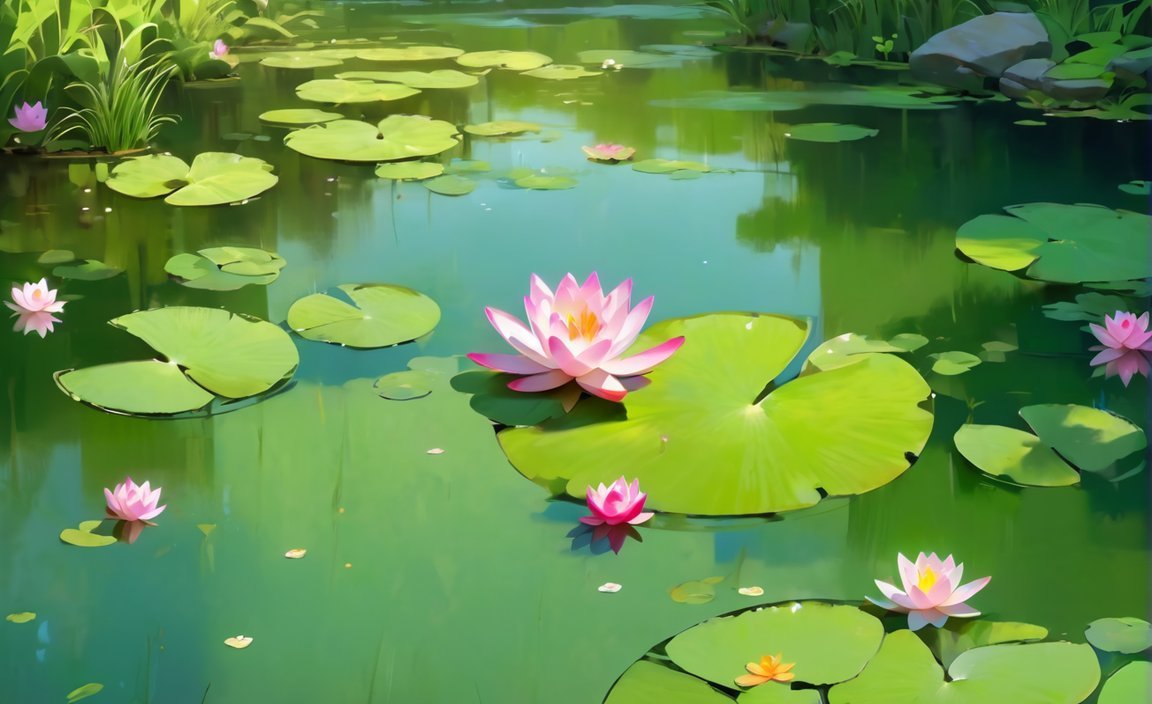
FAQ
Q1: What is the largest pond in the world?
A1: The largest pond in the world is Langley Pond, located in Burnettown, South Carolina. It spans an impressive 285 acres.
Q2: How many ponds are there in the world?
A2: There are more than 100 million ponds worldwide, covering approximately 3.7% of the land surface.
Q3: Can ponds have brackish water conditions?
A3: Yes, some pond habitats can have brackish water conditions, which means they have a mixture of fresh and saltwater.
Q4: How do ponds contribute to carbon storage?
A4: Ponds serve as repositories for carbon, helping to store and sequester carbon dioxide from the atmosphere.
Q5: What are the benefits of ponds for wildlife?
A5: Ponds provide safe havens for many animals, supporting their reproduction and maturity. They are essential habitats for various species, promoting biodiversity and contributing to the overall health of ecosystems.
- China II Review: Delicious Food & Speedy Service - April 17, 2025
- Understand Virginia’s Flag: History & Debate - April 17, 2025
- Explore Long Island’s Map: Unique Regions & Insights - April 17, 2025
